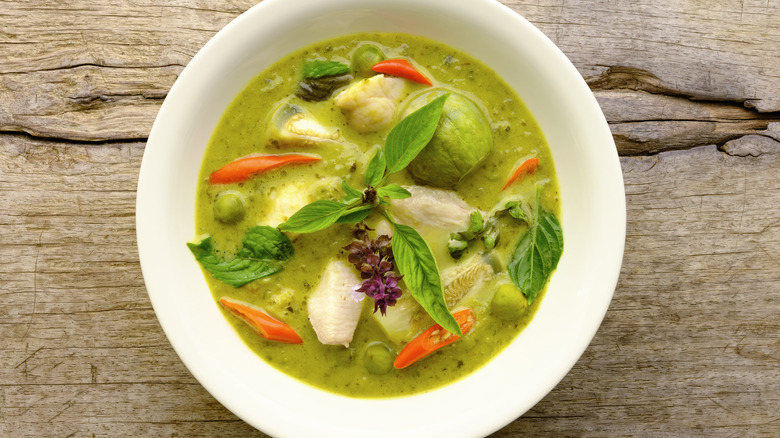Is Canned Coconut Milk Supposed To Separate?
Have you ever been in the midst of preparing some Thai green curry, and opened up a can of coconut milk only to find that it has separated? You're certainly not alone — and it's perfectly normal to see this effect. The simple fact is that the dairy-free product is not supposed to separate at warm temperatures, but it will easily do so if it's too hot or too cold. There are two results that can occur here, and fortunately, neither one means your coconut milk has gone bad nor is it unusable.
In one situation, the fats of the coconut milk rise to the top of the can and solidify, while the liquid stays at the bottom. This is an easy fix, as all you need to do is scoop out the contents of the can, bring everything to a simmer, and stir together. If you need room-temperature coconut milk for something like whipped coconut cream, you can leave the contents out in a warm area for several hours, and then vigorously stir or shake them to reincorporate.
In another scenario, the coconut milk can take on the consistency of curdled dairy milk, with tiny solids floating in the liquid. This situation will require a little bit more attention, but can still be quickly solved. You can place the milk in a blender, and whip everything together until the milk has reformed. Another option is to use a stabilizer such as a teaspoon of cornstarch or tapioca starch. This should bind the milk's contents together, creating a smooth consistency.
Why does coconut milk split and curdle?
Coconut milk will separate if it dips below 57.2 degrees Fahrenheit. In the warm climates where it's produced, this isn't much of an issue, but it easily can be in other places (like your refrigerator when you're storing a can of leftover milk). When coconut milk stays at this temperature, the proteins act as a stabilizer. They keep the oil and water that make up the rest of the product enmeshed in a smooth emulsion. Once the temperature decreases, this bond is broken and the two components separate. This is how you end up with coconut fat on the top of the can and liquid on the bottom.
Interestingly, it's not only lower temperatures that makes coconut milk separate. The same thing will happen once it has been heated past 176 degrees Fahrenheit. As the milk reaches this temperature, the proteins begin to denature and tighten their shape, which in turn affects their ability to bind water and oil together. The proteins eventually become visible as the small lumps that make the milk appear curdled.
Getting the most out of coconut milk when cooking
When setting out to make a recipe like spiced coconut lentil soup, you'll want to select the correct coconut milk to use. Some brands will come loaded with emulsifiers and stabilizing agents like guar gum. While this will help prevent the ingredients from separating, it will also damage the milk's taste and texture. Instead, stick to brands that have as few ingredients as possible. Ideally, these should include just water, coconut, and citric acid.
You should also avoid "lite" coconut milk for cooking applications, as it will have more water added and usually contains extra stabilizers to compensate for its lack of coconut fat. In turn, this will provide a thin texture and weaker taste. In the same breath, cream of coconut (think Coco Lopez) is super sweet and meant for piña coladas, but not as much for savory cooking applications.
Once you've turned your stove on, there are a few easy ways to make sure coconut milk doesn't separate during the cooking process. To begin with, do not bring the liquid to a boil, and always simmer it below 176 degrees Fahrenheit. Similarly, you should regularly stir the pot. This will help emulsify the oil and water, even as their bond becomes weaker under higher heat.



